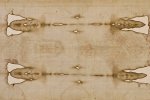- Joined
- Apr 2, 2005
- Messages
- 14,985
- Reaction score
- 2,159
Stuff that may be interesting.

A team of Italian researchers using modern X-ray technology confirmed that the Shroud of Turin, the burial cloth believed to have been used to wrap the tortured body of Jesus Christ and containing an image believed to be that of Christ Himself, was indeed manufactured around the time Jesus walked the Earth – about 2,000 years ago.
This week, artificial intelligence created a striking image based on the image of the authenticated shroud, representing what Jesus was believed to have looked like.
The image spread quickly, downloaded, and shared thousands of times.
First displayed before the public in the 1350s, the Shroud of Turin was presented as the burial cloth Joesph of Arimathea used to wrap the broken body of Jesus Christ after crucifixion and death on the Cross.
However, in the 1980s, scientists cast doubt on this belief after a team of researchers examined the shroud and declared that it dated back only to the Middle Ages—hundreds, if not over a thousand years after Christ’s death.
Now, with more modern and advanced testing procedures contradicting the claims of the scientists who tested the cloth in the 1980s, there’s renewed belief that the fabric that contains the bloodstained imprint of a bearded man with his arms folded is indeed the burial shroud of Christ Himself.

“If the cleaning procedure of the sample is not thoroughly performed, carbon-14 dating is not reliable,” said Dr. Liberato De Caro of the Institute of Crystallography of the National Research Council, the most recent study’s lead author.
“This may have been the case in 1988, as confirmed by experimental evidence showing that when moving from the periphery towards the center of the sheet, along the longest side, there is a significant increase in carbon-14.”
Temperature and humidity factors led researchers to believe the shroud had been kept in temperatures that averaged 72.5 degrees Fahrenheit and 55 percent humidity for 13 centuries before being brought to Europe.
Scientists then compared the cellulose breakdown in the shroud to other fabrics dating back to 1st-century Israel and found them to be a match.
Conversely, none of the fabrics manufactured between 1260 and 1390 AD, the timeframe given by the 1988 researchers, were a match.
The Shroud of Turin has been preserved in the royal chapel of the cathedral of San Giovanni Battista in Turin, Italy, since 1578.
‘True Face of Jesus’: AI Recreates Detailed Image of Jesus Based on Shroud of Turin

A team of Italian researchers using modern X-ray technology confirmed that the Shroud of Turin, the burial cloth believed to have been used to wrap the tortured body of Jesus Christ and containing an image believed to be that of Christ Himself, was indeed manufactured around the time Jesus walked the Earth – about 2,000 years ago.
This week, artificial intelligence created a striking image based on the image of the authenticated shroud, representing what Jesus was believed to have looked like.
The image spread quickly, downloaded, and shared thousands of times.
First displayed before the public in the 1350s, the Shroud of Turin was presented as the burial cloth Joesph of Arimathea used to wrap the broken body of Jesus Christ after crucifixion and death on the Cross.
However, in the 1980s, scientists cast doubt on this belief after a team of researchers examined the shroud and declared that it dated back only to the Middle Ages—hundreds, if not over a thousand years after Christ’s death.
Now, with more modern and advanced testing procedures contradicting the claims of the scientists who tested the cloth in the 1980s, there’s renewed belief that the fabric that contains the bloodstained imprint of a bearded man with his arms folded is indeed the burial shroud of Christ Himself.

“If the cleaning procedure of the sample is not thoroughly performed, carbon-14 dating is not reliable,” said Dr. Liberato De Caro of the Institute of Crystallography of the National Research Council, the most recent study’s lead author.
“This may have been the case in 1988, as confirmed by experimental evidence showing that when moving from the periphery towards the center of the sheet, along the longest side, there is a significant increase in carbon-14.”
Temperature and humidity factors led researchers to believe the shroud had been kept in temperatures that averaged 72.5 degrees Fahrenheit and 55 percent humidity for 13 centuries before being brought to Europe.
Scientists then compared the cellulose breakdown in the shroud to other fabrics dating back to 1st-century Israel and found them to be a match.
Conversely, none of the fabrics manufactured between 1260 and 1390 AD, the timeframe given by the 1988 researchers, were a match.
The Shroud of Turin has been preserved in the royal chapel of the cathedral of San Giovanni Battista in Turin, Italy, since 1578.
